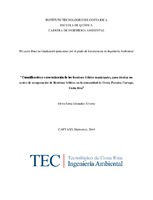Mostrar el registro sencillo del ítem
Cuantificación y caracterización de los Residuos Sólidos municipales, para diseñar un centro de recuperación de Residuos Sólidos, en la comunidad de Orosi, Paraíso, Cartago, Costa Rica
| dc.contributor.author | Granados-Álvarez, Silvia Elena | es |
| dc.date.accessioned | 2015-02-20T14:56:30Z | |
| dc.date.available | 2015-02-20T14:56:30Z | |
| dc.date.issued | 2014 | |
| dc.identifier.uri | https://hdl.handle.net/2238/3331 | |
| dc.description | Proyecto de Graduación (Licenciatura en Ingeniería Ambiental) Instituto Tecnológico de Costa Rica, Escuela de Quimica, 2014. | es |
| dc.description.abstract | The District of Orosi, located in Paradise Canton Province of Cartago, currently lacks Recovery Center Solid Waste so that the management of these is not appropriate for the district. Aiming to make the design of a recovery center, a physical study of the RS in the commercial and residential sectors, the results were used to recommend designing a recovery center recoverable waste was conducted to determine the economic viability and environmental. As study area, the community of Orosi Center, where total 130 homes and 36 businesses were sampled was selected. In the case of housing, its per capita was 0, 34 kg / inhabitant / day and in stores was 0, 22 kg / inhabitant / day; for a total per capita production of 0, 56 kg / inhabitant / day. Also, the composition between homes and businesses varies largely by the difference in nature in the activities carried out. In solid waste average composition was: 31% biodegradable, 17% paper and cardboard, plastic 14%, glass 10%, 6% textile, metal 2%, 1% poly-laminate hazardous% and 17% other. After obtaining these results we proceeded to gauge the recovery center, where the total area obtained through calculations, was 211 m2. The economic feasibility study indicated that it is necessary to recover 58% of the solid waste for self-sustainability of the recovery center. Regarding environmental sustainability, software was used in order to make a comparison to an ideal situation where natural resources have real value, but eventually this aspect was only as a theoretical exercise. At the end of the study concluded that the habits and customs of the people are one of the important points for a correct interpretation of the results obtained in a study of generation and composition. It also found that the per capita generation planning a development project of the solid waste is key to the success of facility design and analysis of financial variables. | en |
| dc.description.sponsorship | Escuela de Quimica, Instituto Tecnológico de Costa Rica. | es |
| dc.language.iso | es | es |
| dc.publisher | Instituto Tecnológico de Costa Rica | es |
| dc.rights | acceso abierto | es |
| dc.subject | Factibilidad | es |
| dc.subject | Flujo de capitales | es |
| dc.subject | Costos de producción | es |
| dc.subject | Reciclaje | es |
| dc.subject | Vivienda | es |
| dc.title | Cuantificación y caracterización de los Residuos Sólidos municipales, para diseñar un centro de recuperación de Residuos Sólidos, en la comunidad de Orosi, Paraíso, Cartago, Costa Rica | es |
| dc.type | proyecto fin de carrera | es |


